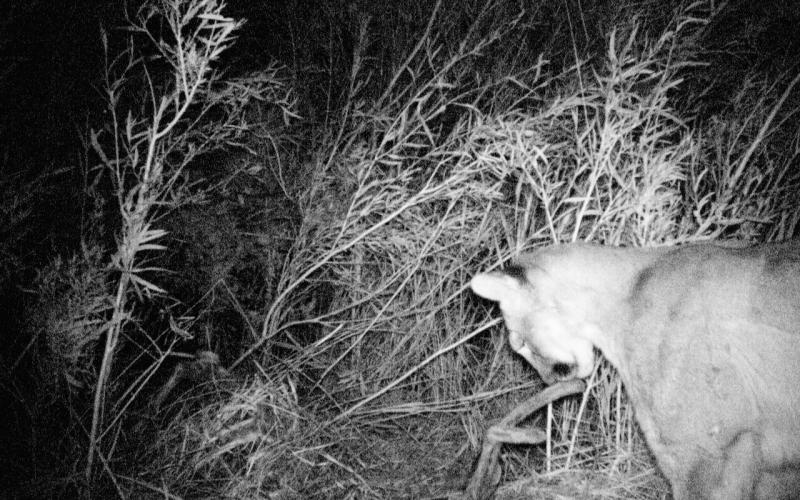
This article is the first in a series of posts showcasing articles published in the Summer 2022 issue of “The Midden”, Great Basin National Park’s semiannual resource management newsletter. The series will introduce you to some of the issues, projects, and management strategies currently happening in Great Basin National Park.
Bryan Hamilton, the Park’s Acting Integrated Resource Management Program Manager, describes the critical role that mountain lions play in the Park’s ecosystem. Hamilton also discusses the challenges of predator management in rural areas and the Park’s approach to this question.
Mountain Lions are Keystone Species
By Bryan Hamilton, acting Integrated Resource Management Program Manager
Mountain lions are keystone species. Through interactions with their prey, mountain lions create “top down” effects that regulate prey abundance and behavior, reduce herbivory, invasive species, and disease transmission, while increasing soil fertility and biodiversity (Beschta and Ripple, 2009). These predator induced trophic cascades can restore and maintain healthy ecosystems (Fraser et al., 2015).
However, predator management is a polarizing issue. Despite the positive effects of predators on ecosystems, mountain lions can be viewed unfavorably, particularly in rural areas.
Further complicating predator management is the rural urban divide. Mountain lion conservation is widely supported in cities and suburbs, but mountain lion habitat is mostly in rural areas on federally managed lands in Nevada. Rural communities that co-exist directly with mountain lions often hold fundamentally different views on wildlife management and unlike urban dwellers, may not support predator conservation (Manfredo et al., 2021).
National Parks find themselves in the middle of this controversy. The mission of Great Basin National Park is to protect its resources and ecosystem processes “unimpaired for future generations”. Apex predators are valued as an integral component of the faunal community but most national parks are not large enough to protect intact predator populations. Large-bodied obligate carnivores like mountain lions must leave the sanctuary of parks, where conflicts between lions may arise. Cooperative conservation is the only effective management strategy for large animals, like mountain lions, which must be managed at landscape scales, across administrative boundaries (Elbroch, 2020).
Cooperative conservation recognizes that wildlife management is a human endeavor. Without community support, dialogue, and engagement, conservation falls flat and difficult problems become more difficult. Despite this reality, most agencies and conservation biologists fail to acknowledge the importance of social differences and human behavior in managing predators.
To improve mountain lion management, Great Basin National Park has applied for Southern Nevada Land Management Act funding to implement the cooperative conservation model. This project will use mountain lion research and management as tools for outreach and community engagement. Mountain lions will be captured and fitted with satellite linked GPS collars. When the GPS locations become tightly clustered, this often means the lion is feeding on prey. After the lion leaves the kill, citizen scientists and school groups will investigate those kills and collect information about patterns of mountain lion predation. The project will also hold regular meetings in Baker and Ely, connect students from urban areas with landowners and livestock producers around the park, and provide training in wildlife techniques. Using these data, scientists can determine the home ranges, abundance, diet, and habitat use of mountain lions. Ultimately this project will improve predator management, ecosystem health, and human well-being through mountain lion research and community engagement.
Photo: Mountain Lion with deer kill, taken from a remote camera in Great Basin National Park. National Park Service
References:
Beschta, R. L., and W. J. Ripple. 2009. Large predators and trophic cascades in terrestrial ecosystems of the western United States. Biological Conservation. 142:2401-2414.
Elbroch, M. 2020. The Cougar Conundrum: Sharing the World with a Successful Predator. Island Press, Washington.Fraser, L. H., W. L. Harrower, H. W. Garris, S. Davidson, P. D. N. Hebert, R. Howie, A. Moody, D. Polster, O. J. Schmitz, A. R. E. Sinclair, B. M. Starzomski, T. P. Sullivan, R. Turkington, and D. Wilson. 2015. A call for applying trophic structure in ecological restoration. Restoration Ecology. 23:503-507.
Manfredo, M. J., R. E. Berl, T. L. Teel, and J. T. Bruskotter. 2021. Bringing social values to wildlife conservation decisions. Frontiers in Ecology and the Environment. 19:355-362.
Rominger, E. M., H. A. Whitlaw, D. L. Weybright, W. C. Dunn, and W. B. Ballard. 2004. The Influence of Mountain Lion Predation on Bighorn Sheep Translocations. The Journal of Wildlife Management. 68:993-999.
